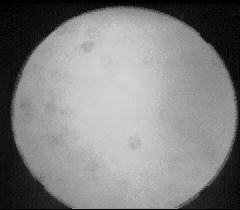Pumice Impact Test (Top View)
|
|
Available formats:
|
High-speed digital sequence of a vertical impact by a copper sphere traveling at 4.5 km/sec into porous pumice (density of about 1g/cc).
A high-speed image sequence (1000 frames per second or one millisecond between each frame) viewed from above a high velocity impacting vertically into a highly porous target of fine particles. This perspective allows looking inside the crater as it forms. In the first frame, a bright "flash" with a streak can be seen. This streak is a high temperature plume resembling a Roman candle that shoots out of the hole created as the projectile penetrates into the target. The second and third frames show a bright plume that eventually becomes obscured as fine debris (ejecta) briefly obscures our view inside. Ejecta moving upward from the impact travel in a thin sheet called the ejecta curtain. The ejecta curtain resembles a funnel, but in an impact the debris flows upward out of the crater, rather than downward. With time an expanding ring begins to form and expands outward. This ring is actually the base of the inclined ejecta curtain (comprised of downward hitting ballistic ejecta particles) striking the surface as it moves outward. Residual fine debris from the upward directed plume partly obscures the crater floor but it gradually clears with time and allows looking inside the final crater.
CREDIT:
NASA Ames Vertical Gun Range, NASA Ames Research Center
Peter H. Schultz, Brown University












